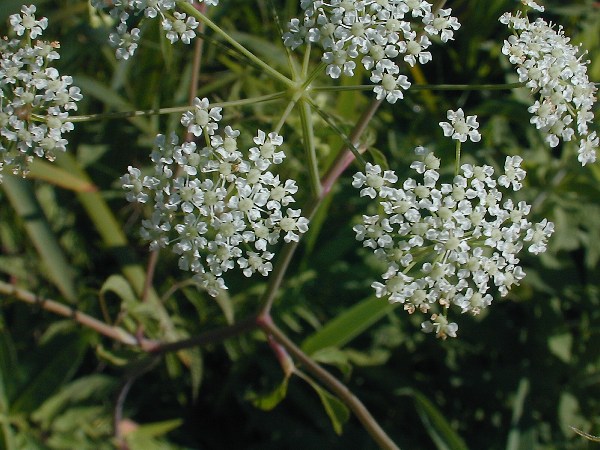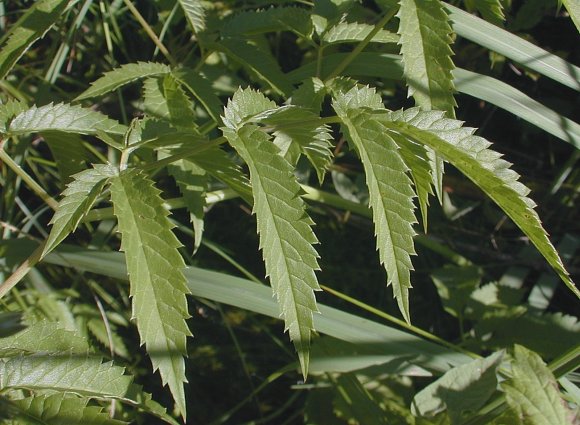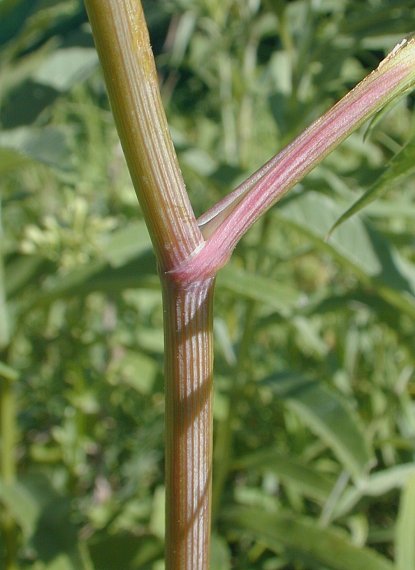Description: This biennial or short-lived perennial plant is 3-6' tall, branching occasionally. The stout stems are terete, glabrous, and sometimes glaucous; they are pale green, pink, or reddish purple, often with prominent longitudinal veins. The lower portion of the central stem is hollow. The compound leaves are odd-pinnate or doubly odd-pinnate; they alternate along the stems. The lower compound leaves are up to 1½' long and ¾' across; the upper compound leaves are much smaller. Each division of a compound leaf typically has 3-7 leaflets. The bases of petioles are partially enclosed by their sheaths; otherwise they are similar to the stems in appearance, although more slender. The glabrous leaflets are 1½-4" long and ½-1¼" across; they are oblong-elliptic with wedge-shaped bottoms, tapered tips, and dentate margins. Sometimes the leaflets fold upward along the length of their central veins. Leaflet venation is pinnate. The lateral veins of leaflets extend to the notches between the teeth, rather than to their tips, along the leaflet margins.

The
upper stems occasionally produce compound umbels of small white
flowers. These compound umbels are up to 6" across and consist of 10-20
umbellets. Individual umbels are dome-shaped on top, rather than flat.
Individual umbellets have about 12-15 flowers that are clustered
together. Each flower is about 1/8" across, consisting of 5 white
petals, an insignificant calyx, 5 white stamens, and a divided style.
The tiny petals are constricted at their bases, and they have notched
tips. The blooming period occurs during mid-summer, lasting about
1 month. The flowers have a slight fragrance that is sometimes
detectable. Afterwards, each flower is replaced by a small angular
fruit containing a pair of seeds. The root system consists of several
fleshy roots at the base of the plant; they are ovoid or oblongoid in
shape. These fleshy roots are exceptionally poisonous; the stems and
foliage are somewhat less poisonous. This plant spreads by reseeding
itself into neighboring areas.
Cultivation:
The preference is full to partial sun and wet to moist conditions. Some
standing water is tolerated, if it is temporary. Either loamy or sandy
soil is acceptable to this plant; it should contain some organic
material to retain moisture. Foliar disease isn't a significant problem
for healthy plants in an appropriate location.

Range &
Habitat:
The native Water Hemlock has been observed in nearly all counties of
Illinois (see Distribution
Map); it is occasional to locally common. Habitats include
moist open
woodlands, swamps, wet prairies, prairie swales, marshes, seeps,
and roadside ditches. Water Hemlock prefers moister locations than the
introduced Conium maculatum (Poison Hemlock), and
so these two species rarely compete with each other for the same
ecological niche. It is not uncommon to find Water Hemlock growing
where Iris virginica shrevei (Blue Flag Iris) also
occurs.
Faunal Associations:
The exposed nectar of the flowers attract primarily insects with short
mouthparts. These floral visitors include leafcutter bees (Megachile spp.),
Halictid bees, cuckoo bees (Sphecodes
spp.), plasterer bees (Colletes
spp.), masked bees (Hylaeus
spp.),
Sphecid wasps, Vespid wasps, Tiphiid wasps, spider wasps (Pompilidae),
velvet ants (Mutillidae), cuckoo wasps (Chrysididae), Eucoilid wasps,
Braconid wasps, soldier flies (Stratiomyidae), Syrphid flies,
thick-headed flies (Conopidae), Tachinid flies, flesh flies
(Sarcophagidae), Muscid flies, and miscellaneous beetles (Robertson,
1929). The larvae of a butterfly, Papilio
polyxenes (Black Swallowtail), feed on the foliage of
Water Hemlock, while the larvae of a moth, Epermenia cicutaella,
feed on the flowers and immature fruits. Several aphids suck plant
juices from this plant, including Cavariella
aegopodii (Carrot-Willow Aphid), Cavariella pastinacae
(Parsnip-Willow Aphid), and Hyadaphis
foeniculi (Honeysuckle-Fennel Aphid). Other insect feeders
include Apion
pensylvanicum (a weevil), Orthops scutellatus
(Carrot Plant Bug), Paroxyna
atlantica (Atlantic Grasshopper), and Paroxyna clavuliger
(Olive-Green Swamp Grasshopper); see Pepper (1965), Blackman &
Eastop (2013), Majka et al. (2007), Wheeler et al. (1983), and Harms
& Grodowitz (2009). The toxic foliage and roots are usually
left
undisturbed by mammalian herbivores, although cattle and other
livestock sometimes eat this plant with dire results. The fleshy roots
are especially toxic: just a small piece can be fatal.

Photographic
Location:
The photographs were taken of plants in a wet prairie along an
abandoned railroad in Champaign County, Illinois. There was 2 ft. of
standing water around the base of the plants as the result of a recent
heavy rainfall, although at other times the site is merely moist.
Comments:
Water Hemlock is a reasonably attractive and eloquent plant, while the
flowers provide nectar to many beneficial insects. It is fairly easy to
distinguish Water Hemlock from other members of the Carrot family
because of its double compound leaves and rather large leaflets that
are rarely lobed. Many other members of the Carrot family have only
simple compound leaves, or their leaflets are much smaller in size, or
their leaflets are deeply lobed. On Water Hemlock, the lateral veins of
the leaflets extend to the notches between the teeth, rather than to
their tips, along the leaf margins. Apparently, no other member of the
Carrot family in Illinois has this characteristic.